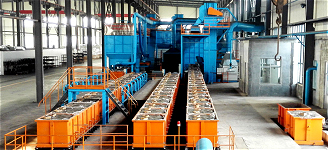
Lost foam casting process is a high-precision, high-efficiency, low-cost, and environmentally friendly casting process suitable for structurally complex castings and large-scale production.Using polystyrene beads to make a solid shape, the shape vaporizes and disappears during pouring, and the metal liquid replaces its position.This process has the characteristics of long mold life, no allowance, and no processing stress, and can cast various metal castings, improving the working environment of the casting workshop.



Castings produced using the lost mold casting process have no burrs, burrs, and mold inclination, reducing dimensional errors caused by core combinations.The casting has precise size and shape, good repeatability, and has the characteristics of precision casting.
The gating system plays a very important role in the lost foam casting process and is the key to the success or failure of casting production.Due to the wide variety and different shapes of castings, each casting has its own specific production process characteristics, and they vary greatly.These factors directly affect the accuracy of the design results of the pouring system.
Adopting mechanical, hydraulic, pneumatic, and electric control methods, the number of sand boxes varies from 10 to 50, and is equipped with a sand cooling system. The annual output is 2000 to 30000 tons, suitable for large-scale production.
The layout principle of the lost foam casting production line is to make the equipment layout as compact as possible, fully utilize space, and shorten the connection distance between the main equipment and various auxiliary equipment as much as possible.
During the production process, there is no need for sand molds and molds, eliminating the need for sand turning, cleaning, bonding, and assembly, greatly improving production efficiency.
Customized design according to the actual needs of customers.
Without the need to remove the model, there is no parting surface, no machining allowance, no deformation after forming, and no mechanical processing stress. It can cast various thin-walled parts with complex shapes and large and medium-sized castings with medium wall thickness.
There are no strict restrictions on the weight and size of castings, making it particularly suitable for casting castings with complex structures.The surface of the casting is smooth and smooth, without defects such as pores and sand holes, which can meet the casting requirements of high-precision components.




The foam plastic gasification mold is mechanically made and then combined and dried.After spraying refractory coating on the surface, dry it again, place the special sand box on the three-dimensional vibrating table, fill in the bottom sand, compact and scrape it, place the dried foam plastic gasification mold on the bottom sand, and fill the sand according to the process requirements.After automatically compacting for a certain period of time, scrape the box mouth flat, cover the sand box mouth with plastic film, place a pouring cup, and connect to the negative pressure system.After compaction, the molten steel shall be cast, the foam plastic mold shall be vaporized and disappear, and the metal liquid shall replace its position. After the casting is condensed, the vacuum shall be released and the box shall be turned over, and the casting shall be taken out for the next cycle.


| size of molding box mm |
Molding efficiency |
Annual output |
Sand processing capacity |
| 2800*2000*350/350 | 6 | 10000 | 5-10 |
| 1750*1600*650/450 | 5-10 | 10000 | 5-10 |
| 1000*800*150/150 | 10-15 | 600-1000 | 5 |
| 2000*1600*360/310 | 10 | 30000 | 35-40 |
| 3100*1900*450/450 | 20 | 50000 | 50 |
*The output will vary according to different materials, feed particle size and other factors
Save Time! Get A Detailed Quotation Quickly.
